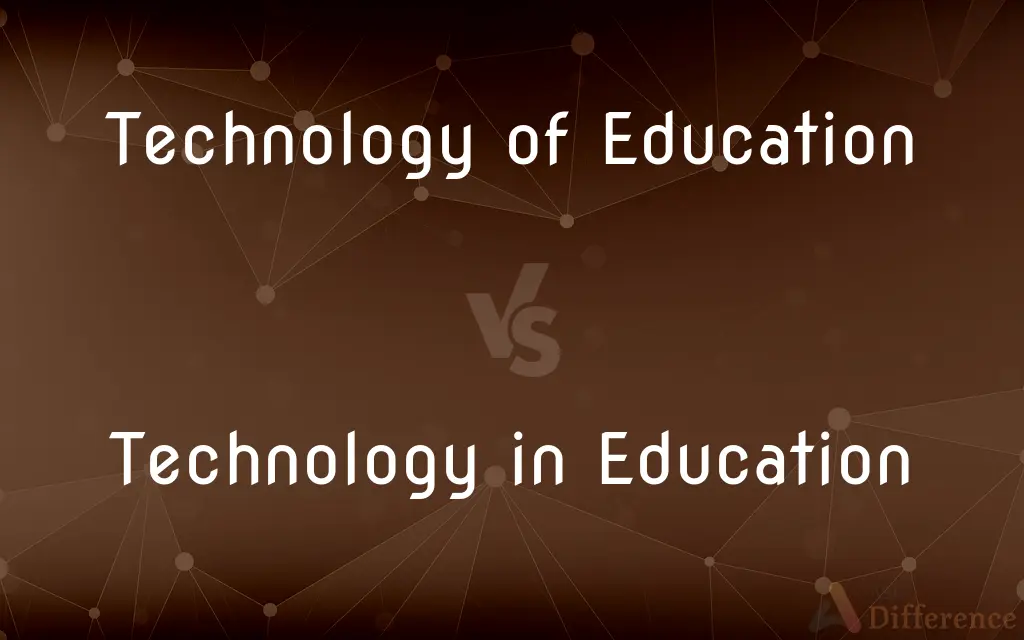Technology of Education vs. Technology in Education — What's the Difference?
By Tayyaba Rehman & Urooj Arif — Published on March 1, 2024
Technology of Education is the study of facilitating learning and improving performance by creating, using, and managing appropriate technological processes and resources. Technology in Education is the practical application of tools and technologies.

Difference Between Technology of Education and Technology in Education
Table of Contents
ADVERTISEMENT
Key Differences
The Technology of Education encompasses the theoretical and methodological aspects behind the use of technology in learning environments. It focuses on how educational technology can be designed, developed, and applied to improve educational practices and outcomes. This field involves research and analysis to understand the best practices for integrating technology into education, emphasizing the development of new teaching methodologies and the ethical implications of technology use in education.
Technology in Education refers to the direct application of technological tools and resources in teaching and learning processes. This includes the use of computers, software applications, the internet, and multimedia in classrooms to enhance the delivery of instruction, facilitate communication, and engage students. It's about the practical ways technology can support teachers and learners in achieving educational goals.
The Technology of Education is concerned with the broader scope of technology's role in shaping educational strategies and theories, while Technology in Education focuses on the hands-on use of technological tools to support specific educational activities. The former is more about the "why" and "how" behind technology's role in education, while the latter is about the "what" and "when" of using technology tools in education.
Both areas are interconnected, yet distinct: the Technology of Education provides the framework and guidelines for how technology should be used in educational contexts, considering pedagogical theories and ethical standards. Technology in Education, however, deals with the implementation of these technologies within educational practices, looking at how they can effectively support teaching and learning.
The development and implementation of educational technologies require a deep understanding of both fields. Designers and educators must consider the pedagogical principles and ethical considerations (Technology of Education) while also being adept at employing specific technologies (Technology in Education) to create engaging and effective learning environments.
ADVERTISEMENT
Comparison Chart
Focus
Theoretical foundations and methodologies
Practical application of tools and resources
Objective
Improve educational practices and outcomes
Enhance learning experiences
Activities
Research, design, ethical analysis
Application of computers, internet, multimedia
Outcome
Development of educational strategies and theories
Support for teaching and learning processes
Considerations
Pedagogical theories, ethical implications
Effective use and integration of technology
Compare with Definitions
Technology of Education
Involves interdisciplinary research.
Experts in psychology, education, and technology collaborate to enhance learning experiences.
Technology in Education
Enhancing communication through technology.
Email and learning management systems streamline teacher-student communication.
Technology of Education
Development of new teaching strategies through technology.
Educators use insights from the Technology of Education to develop flipped classroom models.
Technology in Education
Support for remote and blended learning environments.
Video conferencing tools enable synchronous online classes.
Technology of Education
Emphasizes continuous improvement in educational practices.
The field evaluates the impact of e-learning platforms on student performance.
Technology in Education
Application of software for educational purposes.
Language learning apps facilitate new language acquisition.
Technology of Education
Focus on ethical implications and accessibility.
The Technology of Education addresses concerns about digital divide and equitable access to resources.
Technology in Education
Incorporation of internet resources into teaching.
Students access online databases for research projects.
Technology of Education
Study of designing educational technology and methodologies.
Researchers in the Technology of Education explore the most effective ways to integrate VR into science curricula.
Technology in Education
Utilization of digital tools to support learning.
Teachers use interactive whiteboards to enhance lesson engagement.
Common Curiosities
What is the main difference between the Technology of Education and Technology in Education?
The main difference lies in the focus: Technology of Education is about the theories and methodologies behind using technology in education, while Technology in Education is about the practical application of those technologies in educational settings.
Can the Technology of Education exist without Technology in Education?
While theoretically possible, in practice, the two are interdependent; insights from the Technology of Education guide the effective use of Technology in Education.
What are examples of Technology in Education?
Examples include interactive whiteboards, educational software, online learning platforms, and digital textbooks.
How does the Technology of Education impact student learning?
It provides a framework for developing and implementing technologies that enhance learning experiences, making education more accessible and effective.
Why is the Technology of Education important?
It ensures that the integration of technology into education is pedagogically sound, ethically considered, and effectively enhances teaching and learning outcomes.
Can Technology in Education improve student engagement?
Yes, by incorporating interactive elements, multimedia content, and gamified learning experiences, technology can significantly increase student engagement and motivation.
How does the Technology of Education address different learning styles?
It addresses different learning styles by offering a variety of tools and resources, such as visual aids, interactive simulations, and hands-on activities, allowing students to learn in the way that best suits them.
What future trends are anticipated in the Technology of Education?
Future trends include the increased use of artificial intelligence to personalize learning, virtual and augmented reality for immersive learning experiences, and blockchain technology for secure and transparent educational records.
What are the ethical considerations in the Technology of Education?
Ethical considerations include ensuring equitable access to technology, protecting student privacy and data, and avoiding the over-reliance on technology to the detriment of critical thinking and interpersonal skills.
How do educators keep up with Technology in Education?
Educators may participate in professional development workshops, online courses, and educational technology conferences to stay informed about the latest tools and strategies.
What role does technology play in modern education?
Technology plays a pivotal role in modern education by facilitating personalized learning, enabling remote education, and providing interactive and engaging learning materials that cater to diverse learning styles.
How does Technology in Education enhance teacher effectiveness?
Technology in Education enhances teacher effectiveness by providing tools for creating more engaging lesson plans, assessing student performance in real-time, and allowing for more individualized instruction.
What challenges are associated with implementing Technology in Education?
Challenges include ensuring reliable access to technology for all students, training teachers to effectively use new technologies, and integrating technology in a way that complements the curriculum.
How can Technology in Education support students with disabilities?
Technology can support students with disabilities through adaptive learning software, text-to-speech and speech-to-text applications, and customizable interfaces that cater to various needs.
How do educators assess the effectiveness of Technology in Education?
Educators assess the effectiveness through student performance metrics, engagement levels, feedback surveys, and analyzing whether educational goals and learning outcomes are being met.
Share Your Discovery

Previous Comparison
Glycolic Acid vs. Salicylic Acid
Next Comparison
Step Up Transformer vs. Step Down TransformerAuthor Spotlight
Written by
Tayyaba RehmanTayyaba Rehman is a distinguished writer, currently serving as a primary contributor to askdifference.com. As a researcher in semantics and etymology, Tayyaba's passion for the complexity of languages and their distinctions has found a perfect home on the platform. Tayyaba delves into the intricacies of language, distinguishing between commonly confused words and phrases, thereby providing clarity for readers worldwide.
Co-written by
Urooj ArifUrooj is a skilled content writer at Ask Difference, known for her exceptional ability to simplify complex topics into engaging and informative content. With a passion for research and a flair for clear, concise writing, she consistently delivers articles that resonate with our diverse audience.
















































